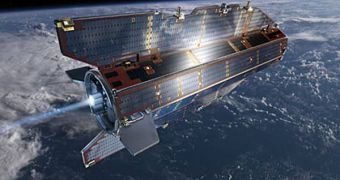The GOCE satellite, the first instrument to observe Earth's gravity in its smallest variations, has recently proven that it can fly drag-free in the upper atmosphere. Situated in a free-fall orbit of about 250 kilometers, which is very close to the surface, yet high enough to ensure that no air molecules slow its movements, the observatory is actually continuously falling through the atmosphere. But, in order to assess the slightest of the gravitational variations, it has to prevent any drag. The way it does that is by using an electricity-driven ion thruster, able to deliver steady propulsion that cancels out drag.
The engine works all the time, but it only generates minimal forces, of between one and 20 millinewtons (mN). As a whole, GOCE (Gravity field and steady-state Ocean Circulation Explorer) does not require a propulsion system of its own, as it does not maintain its orbit by actively correcting it. Rather, its trajectory would seem to an observer as taking the craft to its doom. But the orbit is stable, in that it does not deteriorate easily. All the ion thruster has to do is compensate for any remaining air it comes across.
That is to say, if GOCE is to use its highly advanced gradiometer to measure gravity, then it has to stand relatively still with regard to the Earth, and not experience any drag of its own. If it does that, the readings picked up by its sensitive instruments could be compromised. Basically, any form of drag will be perceived by the gradiometer as a shift in gravity, which is obviously not the case. “I am very pleased to see another world premier by GOCE, after having already demonstrated the first gradiometer technology ever flown in space,” the European Space Agency's (ESA) Director of Earth Observation Programs, Volker Liebig, said recently.
“We were very pleased with the results when the ion propulsion system and the gradiometer, which is the main instrument, were commissioned separately a couple of weeks ago. Now, both systems work together flawlessly – the gradiometer continually senses the air drag and feeds the ion-propulsion system with commands to produce thrusts exactly opposite to the drag being experienced. Initial data indicate that this drag compensation system works 10 times better than what we had expected,” ESA’s GOCE System Manager, Michael Fehringer, added.
“Knowing that the drag-free control system works perfectly means we now have everything in place to carry out the complex process of calibrating the gradiometer instrument. Once calibration has been completed, we will be able to see the true excellence of GOCE’s gravity-field measurements,” ESA’s GOCE Mission Manager, Rune Floberghagen, concluded.

 14 DAY TRIAL //
14 DAY TRIAL //